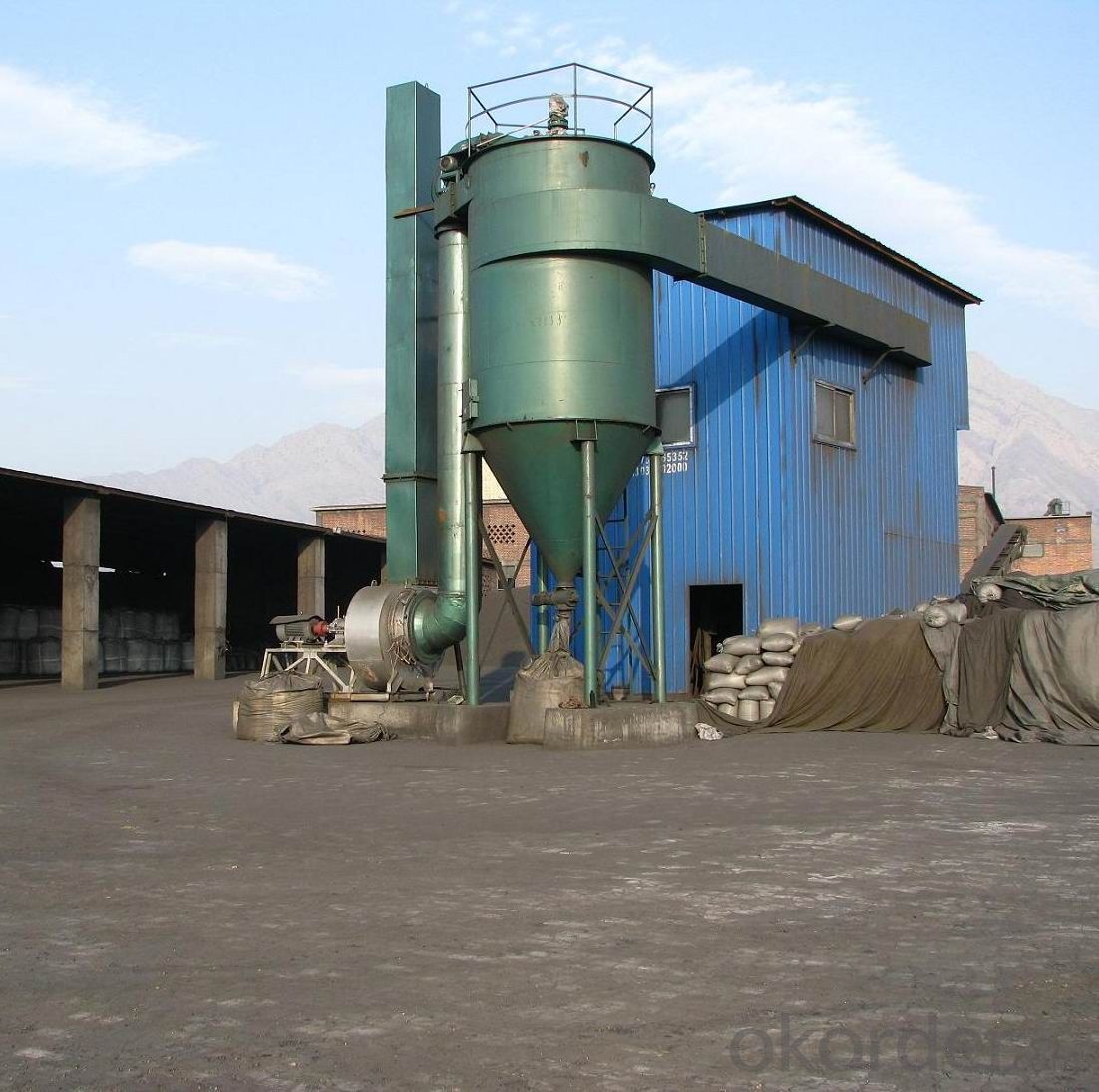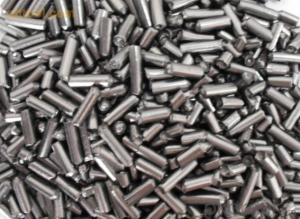Carbon Additve FC 90-95% Specifications
- Loading Port:
- Tianjin
- Payment Terms:
- TT or LC
- Min Order Qty:
- 20 m.t.
- Supply Capability:
- 10000 m.t./month
OKorder Service Pledge
OKorder Financial Service
You Might Also Like
Quick Details
Place of Origin: Ningxia, China (Mainland)
Application: steel making
Shape: granule
Dimensions: FC90-95%
Product Type: Carbon Additive
C Content (%): 90-95% MIN
Working Temperature: -
S Content (%): 0.5%MAX
N Content (%): -
H Content (%): 0.6%MAX
Ash Content (%): 8.5%MAX
Volatile: 2%MAX
ADVANTAGE: low ash & sulfur
COLOR: Black
RAW MATERIAL: TaiXi anthracite
Packaging & Delivery
| Packaging Details: | In 1MT plastic woven bag. |
|---|---|
| Delivery Detail: | 30-40DAYS |
Specifications
Carbon Additve FC 90-95% Specifications
Carbon Additve low Ash,S,P
FC>95% ASH<4% S<0.3%
It is made from TaiXi anthracite.
instead of pertrol coke reduce the cost
Structure
Carbon Additve FC 90-95% Specifications
Shape: granule
Dimensions: FC90-95%
Product Type: Carbon Additive
C Content (%): 90-95% MIN
Working Temperature: -
S Content (%): 0.5%MAX
N Content (%): -
H Content (%): 0.6%MAX
Ash Content (%): 8.5%MAX
Volatile: 2%MAX
ADVANTAGE: low ash & sulfur
COLOR: Black
RAW MATERIAL: TaiXi anthracite
Feature
Carbon Additve FC 90-95% Specifications
Specifications (%): | ||||||
Grade | F.C | Ash | V.M | Moisture | S | Size |
CR-95 | ≥95 | <4 | <1 | <1 | <0.3 | 0-30mm |
CR-94 | ≥94 | <4 | <1 | <1 | <0.3 | |
CR-93 | ≥93 | <6 | <1 | <1 | <0.4 | |
CR-92 | ≥92 | <7 | <1 | <1 | <0.4 | |
CR-91 | ≥91 | <8 | <1 | <1 | <0.4 | |
CR-90 | ≥90 | <8.5 | <1.5 | <2 | <0.4 | |
Image
Carbon Additve FC 90-95% Specifications


FAQ:
Carbon Additve FC 90-95% Specifications
Why we adopt carbon additive?
Carbon Additives used as additive in steel making process. It made from well-selected Tai Xi anthracite which is low in content of ash, sulphur, phosphorus, high heat productivity, high chemically activation.
Mainly industry property of it is: instead of traditional pertroleum coal of Carbon Additives, reduce the cost of steelmaking.
Advantage:
Carbon Additve FC 90-95% Specifications
1.High quality and competitive price.
2.Timely delivery.
3.If any item you like. Please contact us.
Your sincere inquiries are typically answered within 24 hours.
- Q:What is the carbon cycle?
- The movement of carbon dioxide (CO2) between the atmosphere, land, bodies of water, and living organisms comprises the natural process known as the carbon cycle. It serves as a crucial component of Earth's ecosystem, playing a vital role in regulating the planet's climate. The carbon cycle commences with plants absorbing CO2 through photosynthesis. CO2 is taken in from the atmosphere and transformed into organic compounds, such as glucose, used for growth and energy. This process is referred to as carbon fixation. Animals and other consumers acquire carbon by consuming plants or other animals that have already incorporated carbon into their tissues. When plants and animals respire, they release CO2 back into the atmosphere, completing the initial stage of the cycle. Decomposers, including bacteria and fungi, contribute to another pathway in the carbon cycle by decomposing organic matter. During decomposition, carbon is released as CO2 or enters the soil as organic carbon. This stored carbon can later be released into the atmosphere through microbial respiration or erosion. The exchange of carbon between the atmosphere and bodies of water is also involved in the carbon cycle. When CO2 dissolves in water, it forms carbonic acid, leading to ocean acidification. Marine plants, such as algae and phytoplankton, play a critical role in the cycle by photosynthesizing and absorbing CO2 from the water. Geological processes, such as volcanic activity and weathering, additionally release carbon into the atmosphere. Over extended periods, carbon can be stored in the Earth's crust as fossil fuels like coal, oil, and natural gas. The burning of these fossil fuels for energy releases significant amounts of CO2, contributing to the greenhouse effect and climate change. The carbon cycle is an ongoing and intricate process that maintains a delicate balance of carbon in the Earth's atmosphere and ecosystems. However, human activities, particularly the burning of fossil fuels and deforestation, have profoundly disrupted this balance by releasing excessive amounts of CO2 into the atmosphere. This disruption has resulted in global warming and other environmental issues, underscoring the importance of comprehending and mitigating human impacts on this crucial natural process.
- Q:What are the effects of carbon emissions on the stability of estuaries?
- Carbon emissions have significant effects on the stability of estuaries. Estuaries are highly productive and diverse ecosystems that serve as a crucial habitat for numerous species, including fish, birds, and other wildlife. However, excessive carbon emissions, primarily in the form of carbon dioxide (CO2), contribute to climate change and ocean acidification, which in turn have detrimental effects on estuaries. One of the most prominent effects of carbon emissions on estuaries is the rise in sea levels. As global temperatures increase due to carbon emissions, glaciers and ice caps melt, leading to a rise in sea levels. Estuaries, being low-lying areas where rivers meet the sea, are particularly vulnerable to this sea-level rise. Higher water levels can result in increased flooding, erosion, and saltwater intrusion into freshwater systems within estuaries, impacting the overall stability of these ecosystems. Moreover, the increased concentration of CO2 in the atmosphere leads to ocean acidification. When CO2 dissolves in seawater, it reacts with water to form carbonic acid, which lowers the pH of the water. This acidification has detrimental effects on the marine life within estuaries, including shellfish, oysters, and other organisms with calcium carbonate shells. The acidity makes it more difficult for these organisms to build and maintain their shells, leading to reduced populations and biodiversity within estuaries. Additionally, climate change caused by carbon emissions alters the temperature and precipitation patterns in estuaries, affecting the balance of salinity and freshwater influx. Estuaries rely on a delicate balance of saltwater and freshwater to support their unique ecosystems. Changes in temperature and precipitation can disrupt this balance, leading to significant shifts in species composition and distribution. Some species may struggle to adapt to these changes, while invasive species may thrive, further altering the stability and integrity of estuarine ecosystems. Overall, the effects of carbon emissions on the stability of estuaries are profound and multifaceted. Rising sea levels, ocean acidification, and climate-induced changes in salinity and freshwater availability all contribute to the degradation of estuaries and the loss of biodiversity. It is crucial to reduce carbon emissions and mitigate climate change to protect and preserve these vital ecosystems for future generations.
- Q:How does carbon impact the stability of tundra ecosystems?
- The stability of tundra ecosystems is impacted by carbon in several ways. To begin with, carbon is essential for the formation and development of tundra soils. When plants in the tundra grow and undergo photosynthesis, they absorb carbon dioxide from the atmosphere and convert it into organic matter. This organic matter eventually decomposes, adding carbon to the soil and creating a layer of permafrost rich in organic material. This layer of permafrost helps to stabilize the ecosystem. Furthermore, carbon in the form of vegetation acts as a protective layer against erosion in tundra ecosystems. The dense cover of mosses, lichens, and shrubs holds the soil in place, preventing it from being washed away by wind or water. This stabilization is crucial in the tundra, where plant growth and soil development are limited by cold temperatures and short growing seasons. Moreover, the stability of tundra ecosystems is influenced by the release of greenhouse gases, such as carbon dioxide and methane, from the melting permafrost. As global temperatures rise, the permafrost thaws and releases stored carbon into the atmosphere. This process creates a feedback loop, as the released carbon contributes to further warming, which accelerates permafrost thawing. This feedback loop has the potential to disrupt tundra ecosystems by altering the balance of plant and animal life, disrupting nutrient cycling, and increasing the risk of wildfires. In conclusion, carbon plays a vital role in maintaining the stability of tundra ecosystems by contributing to soil formation, preventing erosion, and regulating greenhouse gas emissions. It is crucial to understand and manage carbon dynamics in the tundra in order to preserve these unique and delicate ecosystems in the face of climate change.
- Q:What is the role of carbon in the formation of diamonds?
- The role of carbon in the formation of diamonds is crucial as it is the sole element responsible for the creation of these precious gemstones. Diamonds are formed deep within the Earth's mantle, under extreme pressure and temperature conditions. Carbon atoms, when subjected to immense pressure and heat, undergo a process called graphitization, where they rearrange their atomic structure and transform into a crystal lattice arrangement, giving rise to the formation of diamonds. The process starts with carbon-rich materials, such as organic matter or carbon-bearing minerals, being exposed to the intense heat and pressure found deep within the Earth's mantle, typically at depths of around 150 to 200 kilometers. Under these conditions, the carbon atoms within these materials are forced to bond together in a unique way, forming the rigid, three-dimensional lattice structure characteristic of diamonds. The formation of diamonds requires specific geological conditions, including temperatures above 900 degrees Celsius and pressures exceeding 725,000 pounds per square inch (50,000 atmospheres). These extreme conditions are typically found in areas where ancient tectonic plates collide or in volcanic eruptions that bring diamonds to the Earth's surface. Carbon's ability to form strong covalent bonds with other carbon atoms is what allows the transformation into diamonds. Each carbon atom forms four strong covalent bonds, creating a tetrahedral structure. This strong bonding allows diamonds to possess exceptional hardness, making them one of the hardest substances known to man. In summary, carbon plays an essential role in the formation of diamonds, undergoing graphitization under immense pressure and temperature conditions to create the unique crystal lattice structure that gives diamonds their extraordinary properties. Without carbon, the formation of diamonds as we know them would not be possible.
- Q:What are the main sources of carbon on Earth?
- The main sources of carbon on Earth are both natural and anthropogenic (caused by human activity). In terms of natural sources, carbon is present in the Earth's atmosphere in the form of carbon dioxide (CO2), which is released through natural processes such as volcanic eruptions, respiration by plants and animals, and the decay of organic matter. Carbon is also found in the Earth's lithosphere in the form of carbonate rocks, such as limestone and dolomite, which are formed from the shells and skeletons of marine organisms. Anthropogenic sources of carbon are primarily associated with the burning of fossil fuels, such as coal, oil, and natural gas, for energy production and transportation. When these fossil fuels are burned, carbon dioxide is released into the atmosphere, contributing to the greenhouse effect and climate change. Deforestation and land-use changes also release carbon stored in trees and vegetation into the atmosphere. Additionally, human activities like industrial processes, cement production, and waste management contribute to the emission of carbon dioxide and other greenhouse gases. These activities release carbon that has been locked away for millions of years, significantly altering the natural carbon cycle. Overall, while carbon is naturally present on Earth, human activities have significantly increased its release into the atmosphere, leading to concerns about climate change and the need for sustainable practices to reduce carbon emissions.
- Q:What is the composition of carbon in stainless steel?
- Adjust the hardness, general carbon content, the higher the relative hardness is relatively hard. But no, the higher the better, the carbon content needs to be well controlled. For example, if the welding position is too high carbon, it will lead to brittle weld and easy to crack.
- Q:What is carbon fiber reinforced plastic?
- By combining carbon fibers with a polymer matrix, namely epoxy resin, carbon fiber reinforced plastic (CFRP) is produced. Its exceptional strength-to-weight ratio sets it apart as a lightweight alternative to conventional materials like steel and aluminum. The carbon fibers offer high tensile strength and stiffness, while the polymer matrix evenly distributes the load and ensures durability. The manufacturing process involves layering carbon fiber sheets or fabrics and saturating them with the polymer resin. Subsequently, this combination is cured under high temperature and pressure, resulting in a solid and rigid structure. The resulting material is incredibly strong, yet significantly lighter than materials of comparable strength, such as steel. Thanks to its unique properties, CFRP finds widespread applications in various industries. In aerospace and automotive sectors, it is commonly employed to reduce component weight and enhance fuel efficiency. Moreover, it finds use in sports equipment like bicycles, tennis rackets, and golf clubs, as it enables superior performance and maneuverability. The construction industry also utilizes CFRP, benefiting from its high strength and corrosion resistance for reinforcing structures like bridges and buildings. All in all, carbon fiber reinforced plastic is a versatile and high-performance material that combines the strength of carbon fibers with the flexibility of a polymer matrix. Its lightweight nature and exceptional mechanical properties make it a favored choice in industries where strength, weight reduction, and durability are paramount.
- Q:How does carbon dioxide affect the acidity of rainwater?
- Carbon dioxide affects the acidity of rainwater by contributing to the formation of carbonic acid. When carbon dioxide dissolves in rainwater, it reacts with water molecules to form carbonic acid. This reaction increases the concentration of hydrogen ions (H+) in the water, leading to a decrease in pH and the formation of acidic rainwater. The carbonic acid formed from carbon dioxide is a weak acid, but it can still lower the pH of rainwater, making it more acidic than normal. This increased acidity can have detrimental effects on the environment, including damaging plant and animal life, corroding buildings and infrastructure, and affecting aquatic ecosystems.
- Q:Organic matter is converted from organic carbon. Why is humus represented by carbon instead of converted?
- Therefore, only there is a certain relationship between soil carbon content and soil organic matter, high carbon content of soil humus certain, but it does not explain the soil organic matter, because organic matter contains not only the humus, also contains many other organic substances are not decomposed.
- Q:What are the consequences of increased carbon emissions on forest ecosystems?
- Forest ecosystems experience significant consequences due to the increase in carbon emissions. One of the most notable effects is the modification of climate and weather patterns. The excessive presence of carbon dioxide in the atmosphere results in the retention of heat, leading to global warming. This rise in temperature can disrupt the delicate equilibrium of forest ecosystems. The warmer temperatures can cause shifts in the distribution and composition of tree species, as some may struggle to adapt to the changing conditions. Another outcome of the rise in carbon emissions is the acidification of rainwater. When carbon dioxide combines with water vapor, it creates carbonic acid, which can fall as acid rain. Acid rain has detrimental impacts on forest ecosystems, as it extracts vital nutrients from the soil and damages tree leaves and other vegetation. This weakens the overall health of the forest and makes it more susceptible to diseases and pests. Moreover, increased carbon emissions contribute to the intensification of wildfires. Higher temperatures and drier conditions provide an ideal environment for fires to spread and occur more frequently. Forests that have evolved to withstand natural fire patterns may struggle to cope with the increased intensity and frequency of these fires. This can result in the loss of biodiversity, destruction of habitat, and long-term degradation of forest ecosystems. Lastly, increased carbon emissions contribute to the phenomenon known as ocean acidification, where excess carbon dioxide is absorbed by the oceans. This acidification can impact the well-being of coastal and marine ecosystems, which are intricately connected to forest ecosystems. Many forest ecosystems, such as mangroves and salt marshes, serve as important nursery habitats for marine species. If these forest ecosystems decline due to carbon emissions, it can have cascading effects on the health and productivity of coastal and marine ecosystems. Overall, the increase in carbon emissions has wide-ranging consequences on forest ecosystems. It alters climate patterns, causes acid rain, intensifies wildfires, and affects coastal and marine ecosystems. These impacts not only harm the trees and vegetation within the forests but also disrupt the delicate balance of the entire ecosystem, resulting in the loss of biodiversity and long-term degradation. It is crucial to mitigate carbon emissions and promote sustainable practices to minimize these consequences and preserve the health and integrity of forest ecosystems.
1. Manufacturer Overview |
|
|---|---|
| Location | |
| Year Established | |
| Annual Output Value | |
| Main Markets | |
| Company Certifications | |
2. Manufacturer Certificates |
|
|---|---|
| a) Certification Name | |
| Range | |
| Reference | |
| Validity Period | |
3. Manufacturer Capability |
|
|---|---|
| a)Trade Capacity | |
| Nearest Port | |
| Export Percentage | |
| No.of Employees in Trade Department | |
| Language Spoken: | |
| b)Factory Information | |
| Factory Size: | |
| No. of Production Lines | |
| Contract Manufacturing | |
| Product Price Range | |
Send your message to us
Carbon Additve FC 90-95% Specifications
- Loading Port:
- Tianjin
- Payment Terms:
- TT or LC
- Min Order Qty:
- 20 m.t.
- Supply Capability:
- 10000 m.t./month
OKorder Service Pledge
OKorder Financial Service
Similar products
New products
Hot products
Hot Searches
Related keywords





























